Data Management and Analytics Report for Retail Bank (MIS 609)
VerifiedAdded on 2023/01/13
|12
|2648
|34
Report
AI Summary
This report comprehensively addresses data management and analytics challenges faced by a retail bank with 600,000 customers, focusing on existing issues like outdated systems, reliance on Excel, and security concerns. It proposes a new IT system to handle customer data and satisfaction effectively. The report explores essential data management operations, including gathering, organizing, and protecting data, and emphasizes cloud-based solutions for data processing and storage. It delves into data architecture, data quality measures (accuracy, reliability, completeness), metadata management, handling legacy data through migration and archival, and data governance practices to ensure data integrity and security. Expected benefits include improved operational efficiency, enhanced customer service, and reduced time-to-market. The report concludes by highlighting the significance of data management in resolving the bank's issues and improving customer satisfaction.
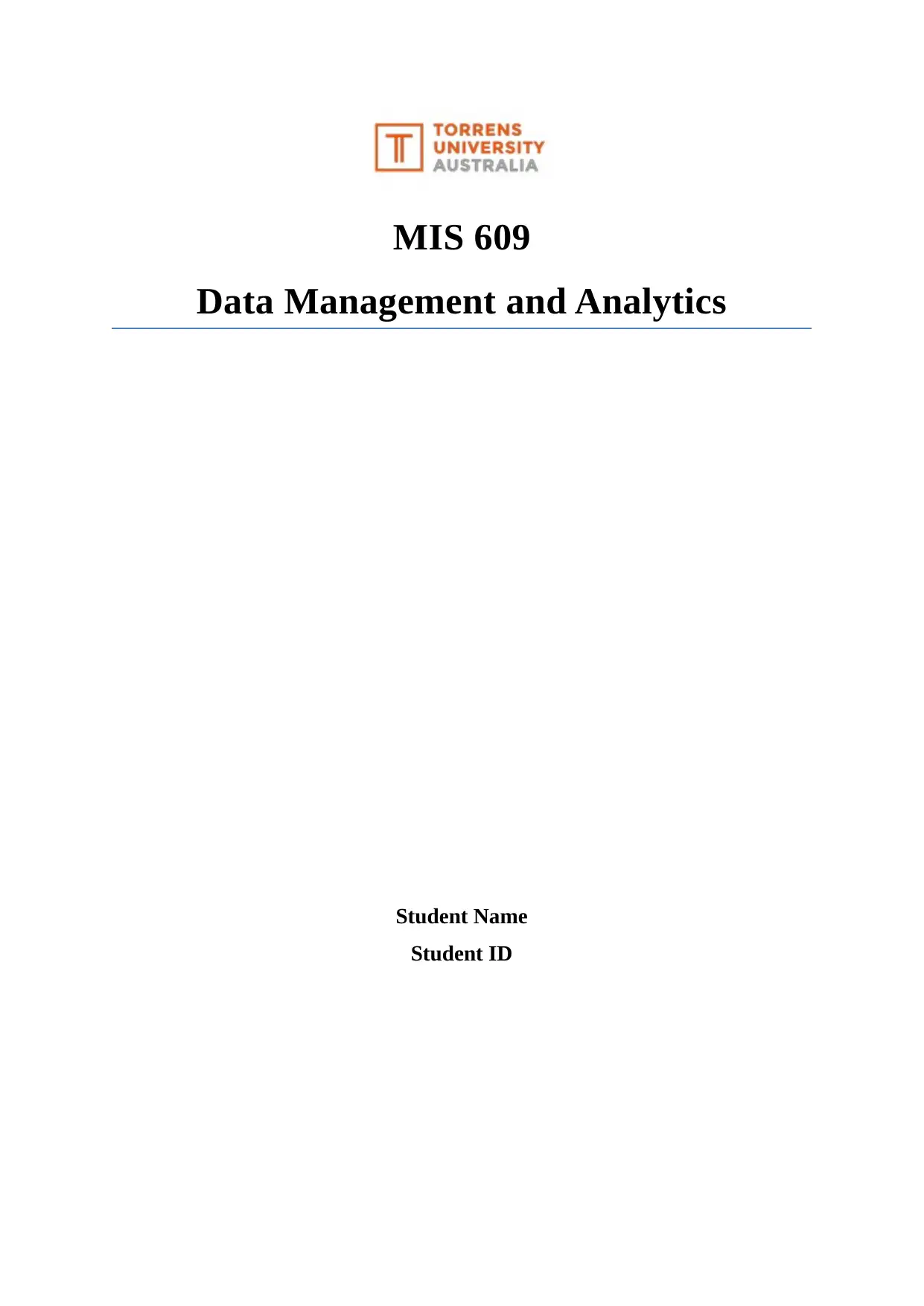
MIS 609
Data Management and Analytics
Student Name
Student ID
Data Management and Analytics
Student Name
Student ID
Paraphrase This Document
Need a fresh take? Get an instant paraphrase of this document with our AI Paraphraser
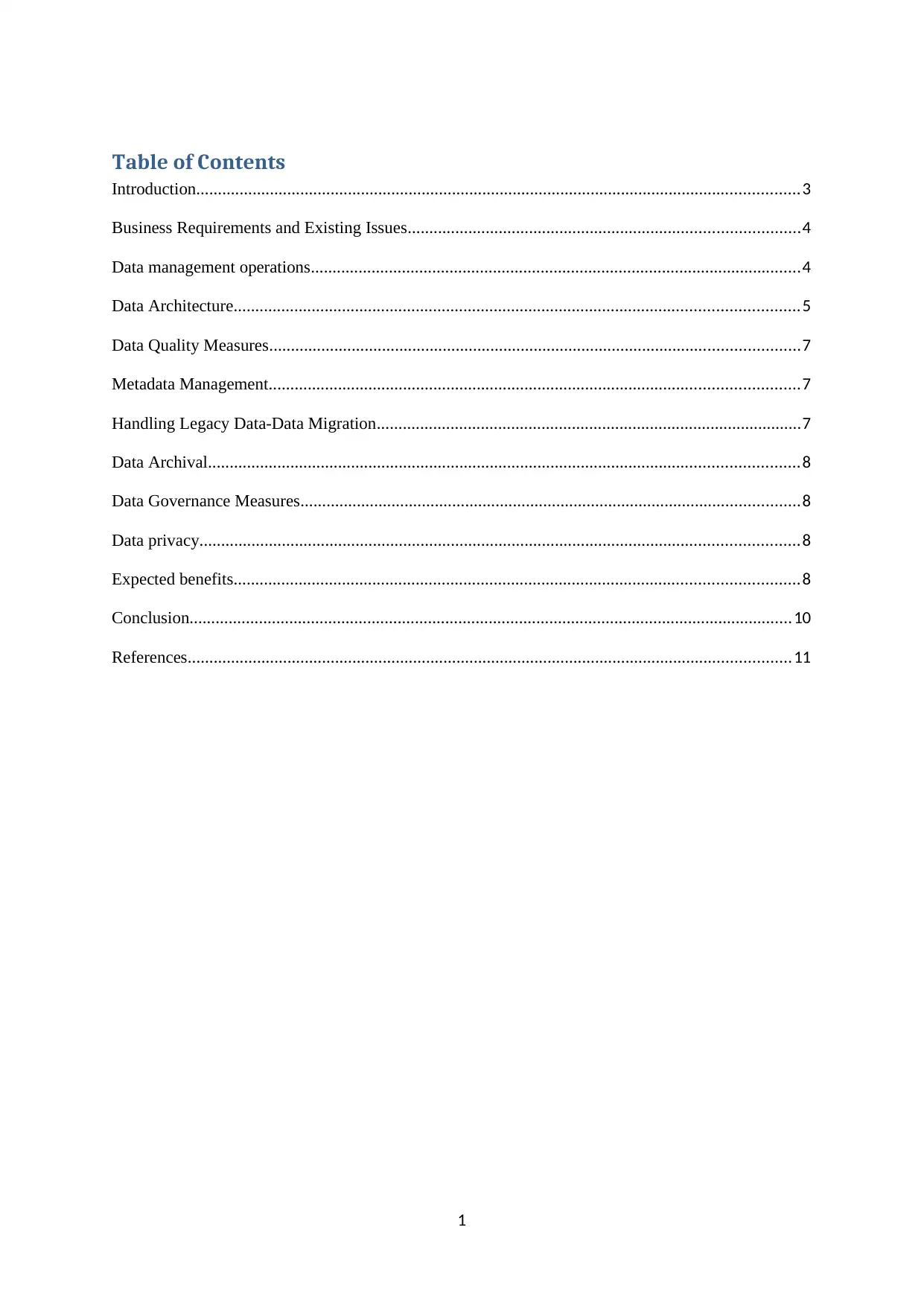
Table of Contents
Introduction...........................................................................................................................................3
Business Requirements and Existing Issues..........................................................................................4
Data management operations.................................................................................................................4
Data Architecture..................................................................................................................................5
Data Quality Measures..........................................................................................................................7
Metadata Management..........................................................................................................................7
Handling Legacy Data-Data Migration..................................................................................................7
Data Archival........................................................................................................................................8
Data Governance Measures...................................................................................................................8
Data privacy..........................................................................................................................................8
Expected benefits..................................................................................................................................8
Conclusion...........................................................................................................................................10
References...........................................................................................................................................11
1
Introduction...........................................................................................................................................3
Business Requirements and Existing Issues..........................................................................................4
Data management operations.................................................................................................................4
Data Architecture..................................................................................................................................5
Data Quality Measures..........................................................................................................................7
Metadata Management..........................................................................................................................7
Handling Legacy Data-Data Migration..................................................................................................7
Data Archival........................................................................................................................................8
Data Governance Measures...................................................................................................................8
Data privacy..........................................................................................................................................8
Expected benefits..................................................................................................................................8
Conclusion...........................................................................................................................................10
References...........................................................................................................................................11
1
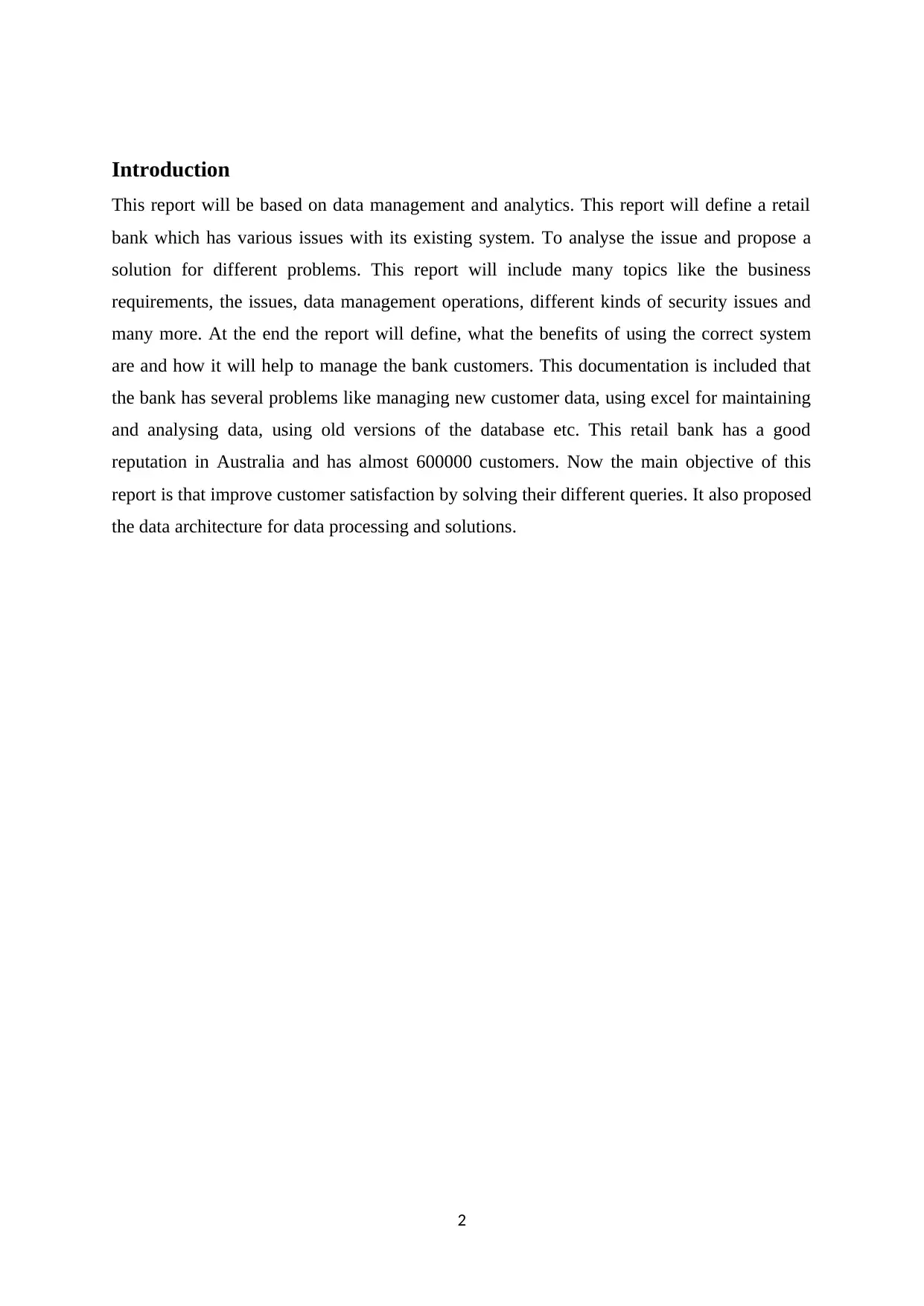
Introduction
This report will be based on data management and analytics. This report will define a retail
bank which has various issues with its existing system. To analyse the issue and propose a
solution for different problems. This report will include many topics like the business
requirements, the issues, data management operations, different kinds of security issues and
many more. At the end the report will define, what the benefits of using the correct system
are and how it will help to manage the bank customers. This documentation is included that
the bank has several problems like managing new customer data, using excel for maintaining
and analysing data, using old versions of the database etc. This retail bank has a good
reputation in Australia and has almost 600000 customers. Now the main objective of this
report is that improve customer satisfaction by solving their different queries. It also proposed
the data architecture for data processing and solutions.
2
This report will be based on data management and analytics. This report will define a retail
bank which has various issues with its existing system. To analyse the issue and propose a
solution for different problems. This report will include many topics like the business
requirements, the issues, data management operations, different kinds of security issues and
many more. At the end the report will define, what the benefits of using the correct system
are and how it will help to manage the bank customers. This documentation is included that
the bank has several problems like managing new customer data, using excel for maintaining
and analysing data, using old versions of the database etc. This retail bank has a good
reputation in Australia and has almost 600000 customers. Now the main objective of this
report is that improve customer satisfaction by solving their different queries. It also proposed
the data architecture for data processing and solutions.
2
⊘ This is a preview!⊘
Do you want full access?
Subscribe today to unlock all pages.

Trusted by 1+ million students worldwide
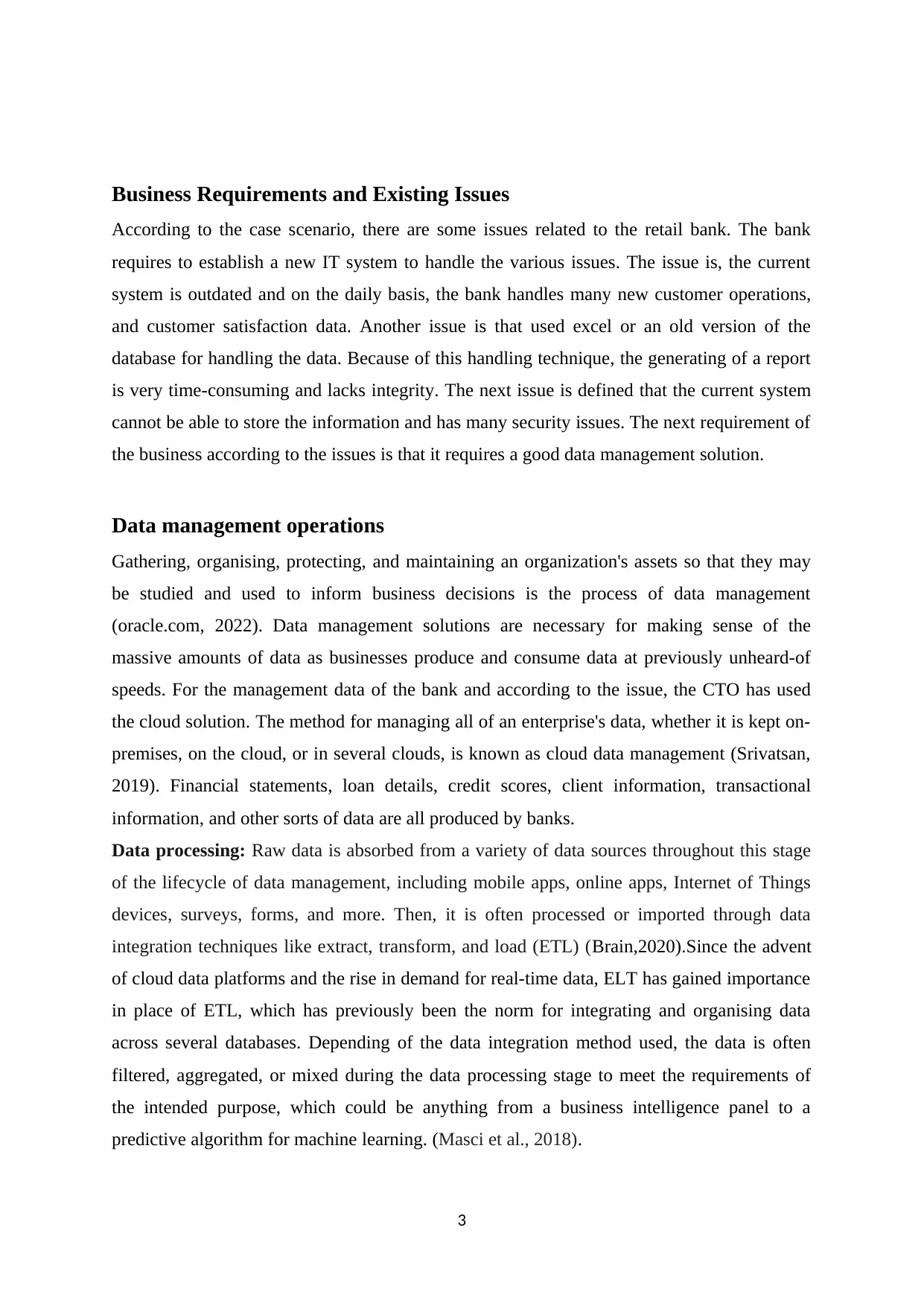
Business Requirements and Existing Issues
According to the case scenario, there are some issues related to the retail bank. The bank
requires to establish a new IT system to handle the various issues. The issue is, the current
system is outdated and on the daily basis, the bank handles many new customer operations,
and customer satisfaction data. Another issue is that used excel or an old version of the
database for handling the data. Because of this handling technique, the generating of a report
is very time-consuming and lacks integrity. The next issue is defined that the current system
cannot be able to store the information and has many security issues. The next requirement of
the business according to the issues is that it requires a good data management solution.
Data management operations
Gathering, organising, protecting, and maintaining an organization's assets so that they may
be studied and used to inform business decisions is the process of data management
(oracle.com, 2022). Data management solutions are necessary for making sense of the
massive amounts of data as businesses produce and consume data at previously unheard-of
speeds. For the management data of the bank and according to the issue, the CTO has used
the cloud solution. The method for managing all of an enterprise's data, whether it is kept on-
premises, on the cloud, or in several clouds, is known as cloud data management (Srivatsan,
2019). Financial statements, loan details, credit scores, client information, transactional
information, and other sorts of data are all produced by banks.
Data processing: Raw data is absorbed from a variety of data sources throughout this stage
of the lifecycle of data management, including mobile apps, online apps, Internet of Things
devices, surveys, forms, and more. Then, it is often processed or imported through data
integration techniques like extract, transform, and load (ETL) (Brain,2020).Since the advent
of cloud data platforms and the rise in demand for real-time data, ELT has gained importance
in place of ETL, which has previously been the norm for integrating and organising data
across several databases. Depending of the data integration method used, the data is often
filtered, aggregated, or mixed during the data processing stage to meet the requirements of
the intended purpose, which could be anything from a business intelligence panel to a
predictive algorithm for machine learning. (Masci et al., 2018).
3
According to the case scenario, there are some issues related to the retail bank. The bank
requires to establish a new IT system to handle the various issues. The issue is, the current
system is outdated and on the daily basis, the bank handles many new customer operations,
and customer satisfaction data. Another issue is that used excel or an old version of the
database for handling the data. Because of this handling technique, the generating of a report
is very time-consuming and lacks integrity. The next issue is defined that the current system
cannot be able to store the information and has many security issues. The next requirement of
the business according to the issues is that it requires a good data management solution.
Data management operations
Gathering, organising, protecting, and maintaining an organization's assets so that they may
be studied and used to inform business decisions is the process of data management
(oracle.com, 2022). Data management solutions are necessary for making sense of the
massive amounts of data as businesses produce and consume data at previously unheard-of
speeds. For the management data of the bank and according to the issue, the CTO has used
the cloud solution. The method for managing all of an enterprise's data, whether it is kept on-
premises, on the cloud, or in several clouds, is known as cloud data management (Srivatsan,
2019). Financial statements, loan details, credit scores, client information, transactional
information, and other sorts of data are all produced by banks.
Data processing: Raw data is absorbed from a variety of data sources throughout this stage
of the lifecycle of data management, including mobile apps, online apps, Internet of Things
devices, surveys, forms, and more. Then, it is often processed or imported through data
integration techniques like extract, transform, and load (ETL) (Brain,2020).Since the advent
of cloud data platforms and the rise in demand for real-time data, ELT has gained importance
in place of ETL, which has previously been the norm for integrating and organising data
across several databases. Depending of the data integration method used, the data is often
filtered, aggregated, or mixed during the data processing stage to meet the requirements of
the intended purpose, which could be anything from a business intelligence panel to a
predictive algorithm for machine learning. (Masci et al., 2018).
3
Paraphrase This Document
Need a fresh take? Get an instant paraphrase of this document with our AI Paraphraser
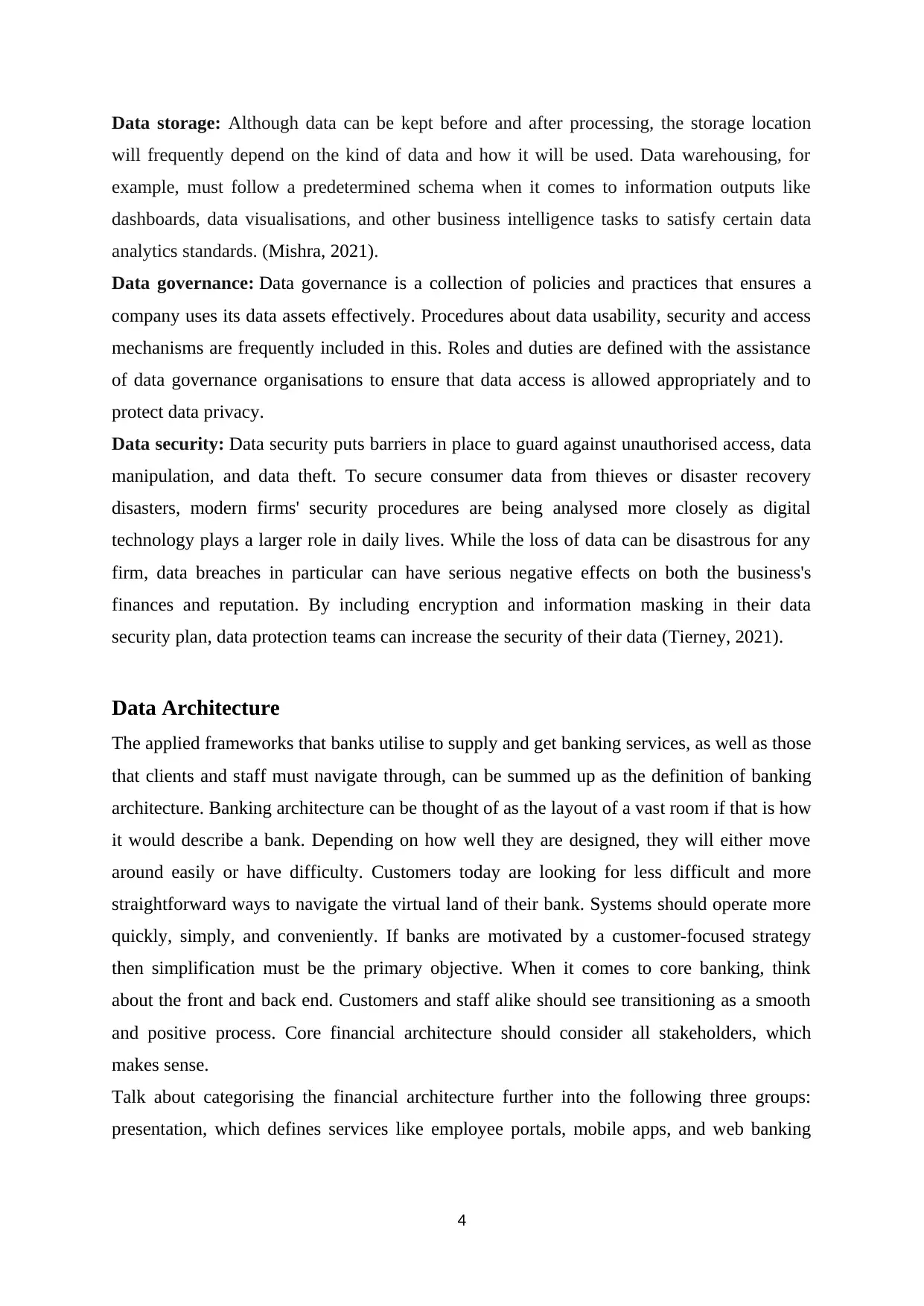
Data storage: Although data can be kept before and after processing, the storage location
will frequently depend on the kind of data and how it will be used. Data warehousing, for
example, must follow a predetermined schema when it comes to information outputs like
dashboards, data visualisations, and other business intelligence tasks to satisfy certain data
analytics standards. (Mishra, 2021).
Data governance: Data governance is a collection of policies and practices that ensures a
company uses its data assets effectively. Procedures about data usability, security and access
mechanisms are frequently included in this. Roles and duties are defined with the assistance
of data governance organisations to ensure that data access is allowed appropriately and to
protect data privacy.
Data security: Data security puts barriers in place to guard against unauthorised access, data
manipulation, and data theft. To secure consumer data from thieves or disaster recovery
disasters, modern firms' security procedures are being analysed more closely as digital
technology plays a larger role in daily lives. While the loss of data can be disastrous for any
firm, data breaches in particular can have serious negative effects on both the business's
finances and reputation. By including encryption and information masking in their data
security plan, data protection teams can increase the security of their data (Tierney, 2021).
Data Architecture
The applied frameworks that banks utilise to supply and get banking services, as well as those
that clients and staff must navigate through, can be summed up as the definition of banking
architecture. Banking architecture can be thought of as the layout of a vast room if that is how
it would describe a bank. Depending on how well they are designed, they will either move
around easily or have difficulty. Customers today are looking for less difficult and more
straightforward ways to navigate the virtual land of their bank. Systems should operate more
quickly, simply, and conveniently. If banks are motivated by a customer-focused strategy
then simplification must be the primary objective. When it comes to core banking, think
about the front and back end. Customers and staff alike should see transitioning as a smooth
and positive process. Core financial architecture should consider all stakeholders, which
makes sense.
Talk about categorising the financial architecture further into the following three groups:
presentation, which defines services like employee portals, mobile apps, and web banking
4
will frequently depend on the kind of data and how it will be used. Data warehousing, for
example, must follow a predetermined schema when it comes to information outputs like
dashboards, data visualisations, and other business intelligence tasks to satisfy certain data
analytics standards. (Mishra, 2021).
Data governance: Data governance is a collection of policies and practices that ensures a
company uses its data assets effectively. Procedures about data usability, security and access
mechanisms are frequently included in this. Roles and duties are defined with the assistance
of data governance organisations to ensure that data access is allowed appropriately and to
protect data privacy.
Data security: Data security puts barriers in place to guard against unauthorised access, data
manipulation, and data theft. To secure consumer data from thieves or disaster recovery
disasters, modern firms' security procedures are being analysed more closely as digital
technology plays a larger role in daily lives. While the loss of data can be disastrous for any
firm, data breaches in particular can have serious negative effects on both the business's
finances and reputation. By including encryption and information masking in their data
security plan, data protection teams can increase the security of their data (Tierney, 2021).
Data Architecture
The applied frameworks that banks utilise to supply and get banking services, as well as those
that clients and staff must navigate through, can be summed up as the definition of banking
architecture. Banking architecture can be thought of as the layout of a vast room if that is how
it would describe a bank. Depending on how well they are designed, they will either move
around easily or have difficulty. Customers today are looking for less difficult and more
straightforward ways to navigate the virtual land of their bank. Systems should operate more
quickly, simply, and conveniently. If banks are motivated by a customer-focused strategy
then simplification must be the primary objective. When it comes to core banking, think
about the front and back end. Customers and staff alike should see transitioning as a smooth
and positive process. Core financial architecture should consider all stakeholders, which
makes sense.
Talk about categorising the financial architecture further into the following three groups:
presentation, which defines services like employee portals, mobile apps, and web banking
4
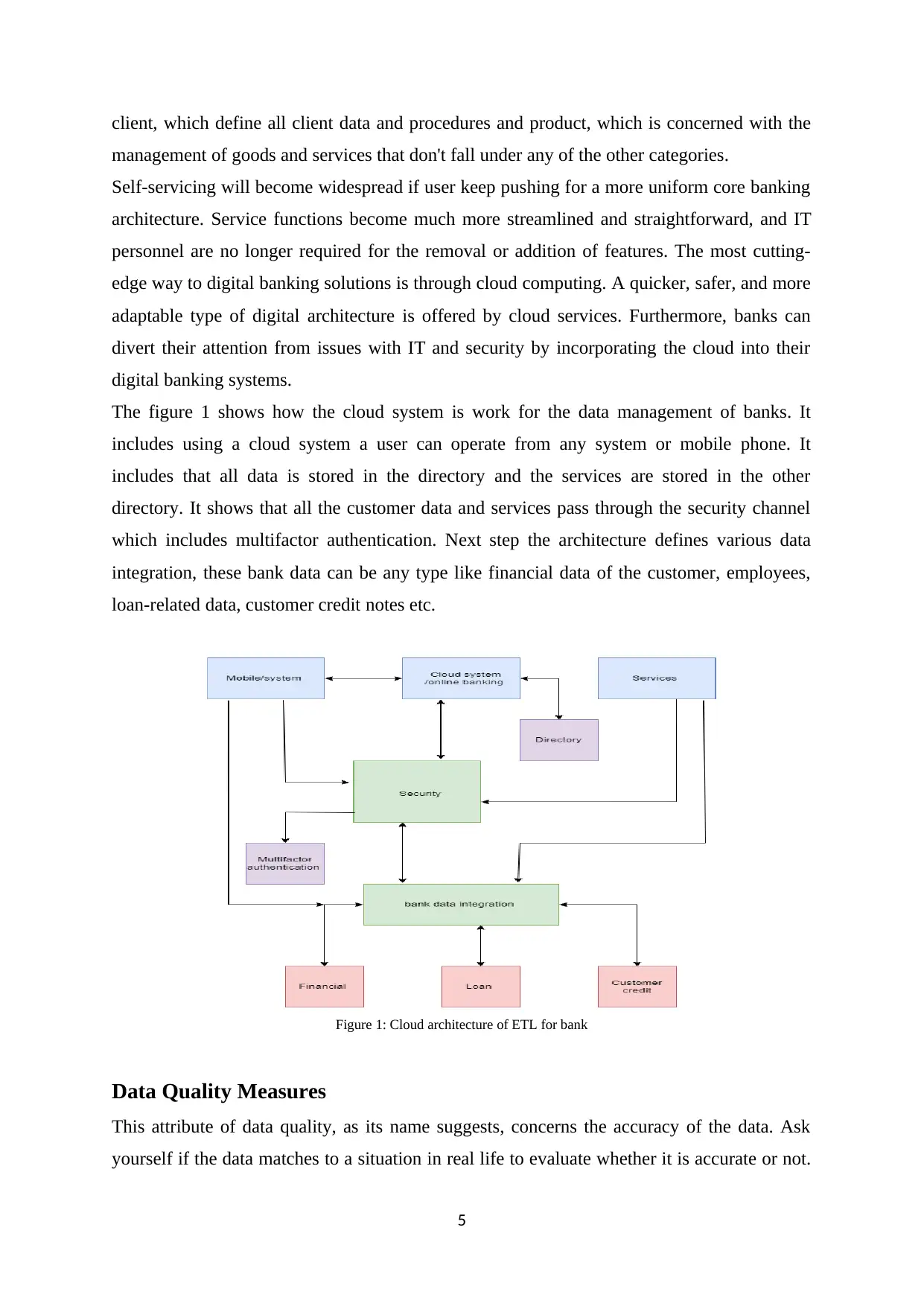
client, which define all client data and procedures and product, which is concerned with the
management of goods and services that don't fall under any of the other categories.
Self-servicing will become widespread if user keep pushing for a more uniform core banking
architecture. Service functions become much more streamlined and straightforward, and IT
personnel are no longer required for the removal or addition of features. The most cutting-
edge way to digital banking solutions is through cloud computing. A quicker, safer, and more
adaptable type of digital architecture is offered by cloud services. Furthermore, banks can
divert their attention from issues with IT and security by incorporating the cloud into their
digital banking systems.
The figure 1 shows how the cloud system is work for the data management of banks. It
includes using a cloud system a user can operate from any system or mobile phone. It
includes that all data is stored in the directory and the services are stored in the other
directory. It shows that all the customer data and services pass through the security channel
which includes multifactor authentication. Next step the architecture defines various data
integration, these bank data can be any type like financial data of the customer, employees,
loan-related data, customer credit notes etc.
Figure 1: Cloud architecture of ETL for bank
Data Quality Measures
This attribute of data quality, as its name suggests, concerns the accuracy of the data. Ask
yourself if the data matches to a situation in real life to evaluate whether it is accurate or not.
5
management of goods and services that don't fall under any of the other categories.
Self-servicing will become widespread if user keep pushing for a more uniform core banking
architecture. Service functions become much more streamlined and straightforward, and IT
personnel are no longer required for the removal or addition of features. The most cutting-
edge way to digital banking solutions is through cloud computing. A quicker, safer, and more
adaptable type of digital architecture is offered by cloud services. Furthermore, banks can
divert their attention from issues with IT and security by incorporating the cloud into their
digital banking systems.
The figure 1 shows how the cloud system is work for the data management of banks. It
includes using a cloud system a user can operate from any system or mobile phone. It
includes that all data is stored in the directory and the services are stored in the other
directory. It shows that all the customer data and services pass through the security channel
which includes multifactor authentication. Next step the architecture defines various data
integration, these bank data can be any type like financial data of the customer, employees,
loan-related data, customer credit notes etc.
Figure 1: Cloud architecture of ETL for bank
Data Quality Measures
This attribute of data quality, as its name suggests, concerns the accuracy of the data. Ask
yourself if the data matches to a situation in real life to evaluate whether it is accurate or not.
5
⊘ This is a preview!⊘
Do you want full access?
Subscribe today to unlock all pages.

Trusted by 1+ million students worldwide
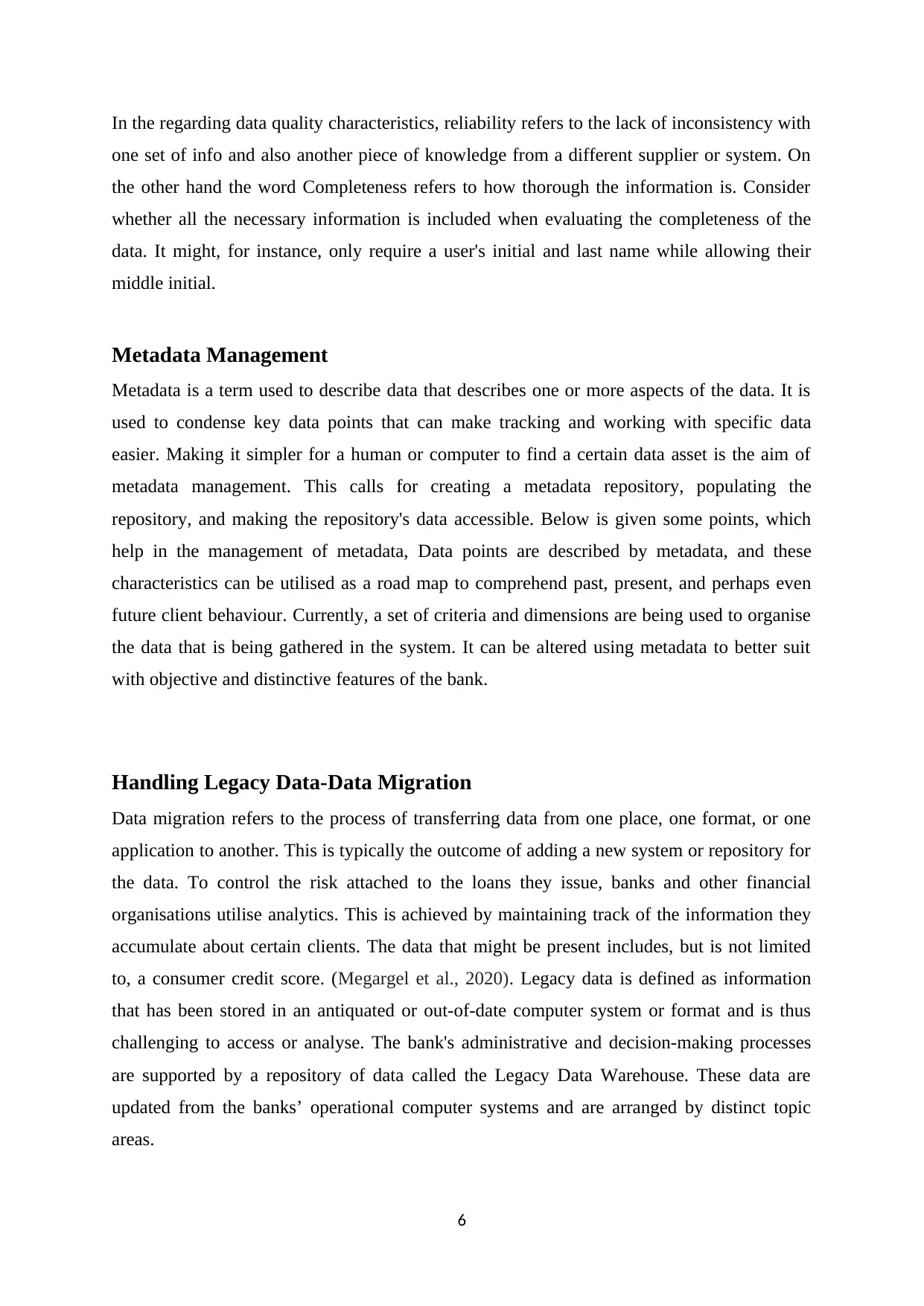
In the regarding data quality characteristics, reliability refers to the lack of inconsistency with
one set of info and also another piece of knowledge from a different supplier or system. On
the other hand the word Completeness refers to how thorough the information is. Consider
whether all the necessary information is included when evaluating the completeness of the
data. It might, for instance, only require a user's initial and last name while allowing their
middle initial.
Metadata Management
Metadata is a term used to describe data that describes one or more aspects of the data. It is
used to condense key data points that can make tracking and working with specific data
easier. Making it simpler for a human or computer to find a certain data asset is the aim of
metadata management. This calls for creating a metadata repository, populating the
repository, and making the repository's data accessible. Below is given some points, which
help in the management of metadata, Data points are described by metadata, and these
characteristics can be utilised as a road map to comprehend past, present, and perhaps even
future client behaviour. Currently, a set of criteria and dimensions are being used to organise
the data that is being gathered in the system. It can be altered using metadata to better suit
with objective and distinctive features of the bank.
Handling Legacy Data-Data Migration
Data migration refers to the process of transferring data from one place, one format, or one
application to another. This is typically the outcome of adding a new system or repository for
the data. To control the risk attached to the loans they issue, banks and other financial
organisations utilise analytics. This is achieved by maintaining track of the information they
accumulate about certain clients. The data that might be present includes, but is not limited
to, a consumer credit score. (Megargel et al., 2020). Legacy data is defined as information
that has been stored in an antiquated or out-of-date computer system or format and is thus
challenging to access or analyse. The bank's administrative and decision-making processes
are supported by a repository of data called the Legacy Data Warehouse. These data are
updated from the banks’ operational computer systems and are arranged by distinct topic
areas.
6
one set of info and also another piece of knowledge from a different supplier or system. On
the other hand the word Completeness refers to how thorough the information is. Consider
whether all the necessary information is included when evaluating the completeness of the
data. It might, for instance, only require a user's initial and last name while allowing their
middle initial.
Metadata Management
Metadata is a term used to describe data that describes one or more aspects of the data. It is
used to condense key data points that can make tracking and working with specific data
easier. Making it simpler for a human or computer to find a certain data asset is the aim of
metadata management. This calls for creating a metadata repository, populating the
repository, and making the repository's data accessible. Below is given some points, which
help in the management of metadata, Data points are described by metadata, and these
characteristics can be utilised as a road map to comprehend past, present, and perhaps even
future client behaviour. Currently, a set of criteria and dimensions are being used to organise
the data that is being gathered in the system. It can be altered using metadata to better suit
with objective and distinctive features of the bank.
Handling Legacy Data-Data Migration
Data migration refers to the process of transferring data from one place, one format, or one
application to another. This is typically the outcome of adding a new system or repository for
the data. To control the risk attached to the loans they issue, banks and other financial
organisations utilise analytics. This is achieved by maintaining track of the information they
accumulate about certain clients. The data that might be present includes, but is not limited
to, a consumer credit score. (Megargel et al., 2020). Legacy data is defined as information
that has been stored in an antiquated or out-of-date computer system or format and is thus
challenging to access or analyse. The bank's administrative and decision-making processes
are supported by a repository of data called the Legacy Data Warehouse. These data are
updated from the banks’ operational computer systems and are arranged by distinct topic
areas.
6
Paraphrase This Document
Need a fresh take? Get an instant paraphrase of this document with our AI Paraphraser
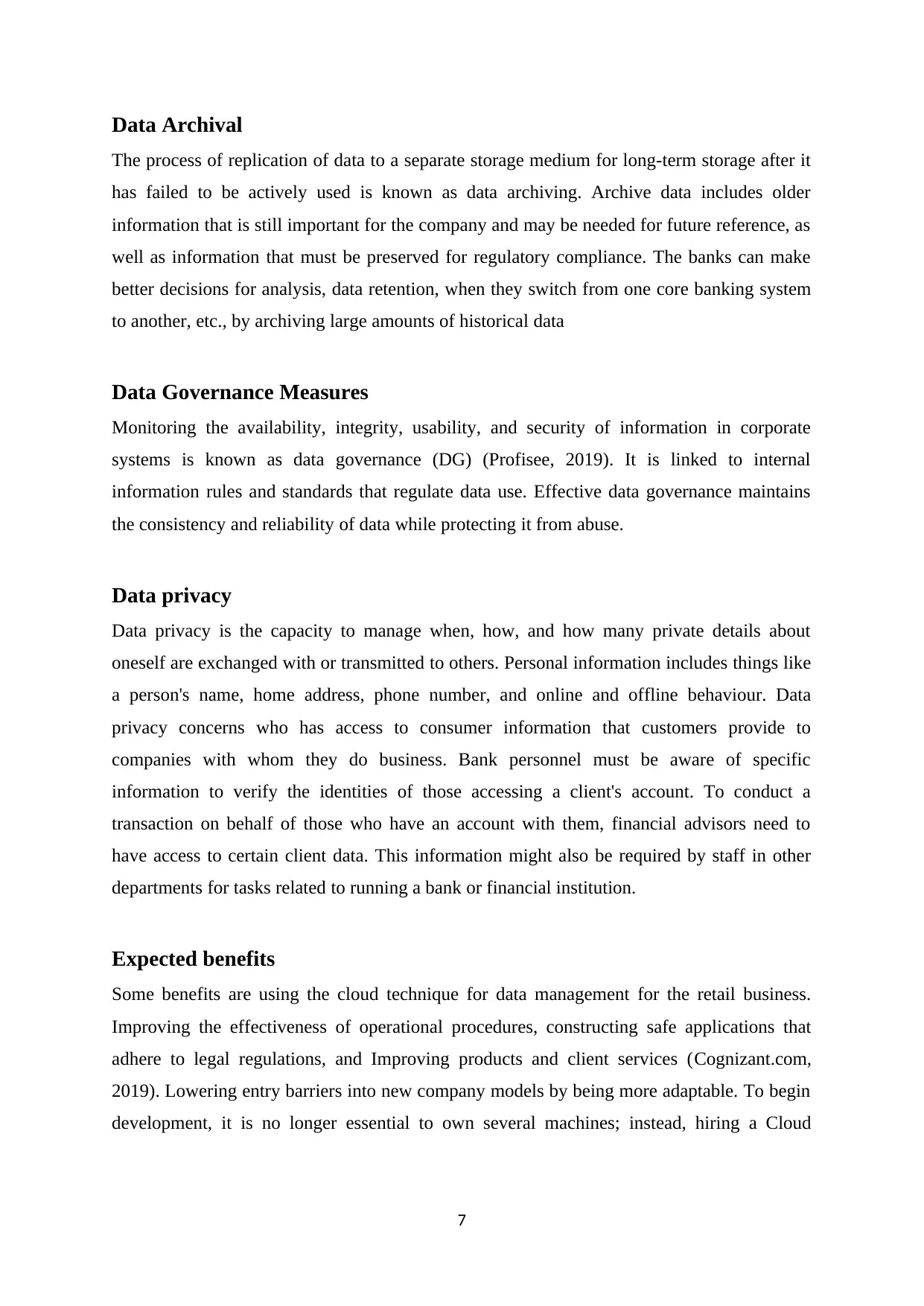
Data Archival
The process of replication of data to a separate storage medium for long-term storage after it
has failed to be actively used is known as data archiving. Archive data includes older
information that is still important for the company and may be needed for future reference, as
well as information that must be preserved for regulatory compliance. The banks can make
better decisions for analysis, data retention, when they switch from one core banking system
to another, etc., by archiving large amounts of historical data
Data Governance Measures
Monitoring the availability, integrity, usability, and security of information in corporate
systems is known as data governance (DG) (Profisee, 2019). It is linked to internal
information rules and standards that regulate data use. Effective data governance maintains
the consistency and reliability of data while protecting it from abuse.
Data privacy
Data privacy is the capacity to manage when, how, and how many private details about
oneself are exchanged with or transmitted to others. Personal information includes things like
a person's name, home address, phone number, and online and offline behaviour. Data
privacy concerns who has access to consumer information that customers provide to
companies with whom they do business. Bank personnel must be aware of specific
information to verify the identities of those accessing a client's account. To conduct a
transaction on behalf of those who have an account with them, financial advisors need to
have access to certain client data. This information might also be required by staff in other
departments for tasks related to running a bank or financial institution.
Expected benefits
Some benefits are using the cloud technique for data management for the retail business.
Improving the effectiveness of operational procedures, constructing safe applications that
adhere to legal regulations, and Improving products and client services (Cognizant.com,
2019). Lowering entry barriers into new company models by being more adaptable. To begin
development, it is no longer essential to own several machines; instead, hiring a Cloud
7
The process of replication of data to a separate storage medium for long-term storage after it
has failed to be actively used is known as data archiving. Archive data includes older
information that is still important for the company and may be needed for future reference, as
well as information that must be preserved for regulatory compliance. The banks can make
better decisions for analysis, data retention, when they switch from one core banking system
to another, etc., by archiving large amounts of historical data
Data Governance Measures
Monitoring the availability, integrity, usability, and security of information in corporate
systems is known as data governance (DG) (Profisee, 2019). It is linked to internal
information rules and standards that regulate data use. Effective data governance maintains
the consistency and reliability of data while protecting it from abuse.
Data privacy
Data privacy is the capacity to manage when, how, and how many private details about
oneself are exchanged with or transmitted to others. Personal information includes things like
a person's name, home address, phone number, and online and offline behaviour. Data
privacy concerns who has access to consumer information that customers provide to
companies with whom they do business. Bank personnel must be aware of specific
information to verify the identities of those accessing a client's account. To conduct a
transaction on behalf of those who have an account with them, financial advisors need to
have access to certain client data. This information might also be required by staff in other
departments for tasks related to running a bank or financial institution.
Expected benefits
Some benefits are using the cloud technique for data management for the retail business.
Improving the effectiveness of operational procedures, constructing safe applications that
adhere to legal regulations, and Improving products and client services (Cognizant.com,
2019). Lowering entry barriers into new company models by being more adaptable. To begin
development, it is no longer essential to own several machines; instead, hiring a Cloud
7

provider will suffice, Additional resources for Mobile First and Increasing speed and agility
to reduce Time to Market.
8
to reduce Time to Market.
8
⊘ This is a preview!⊘
Do you want full access?
Subscribe today to unlock all pages.

Trusted by 1+ million students worldwide
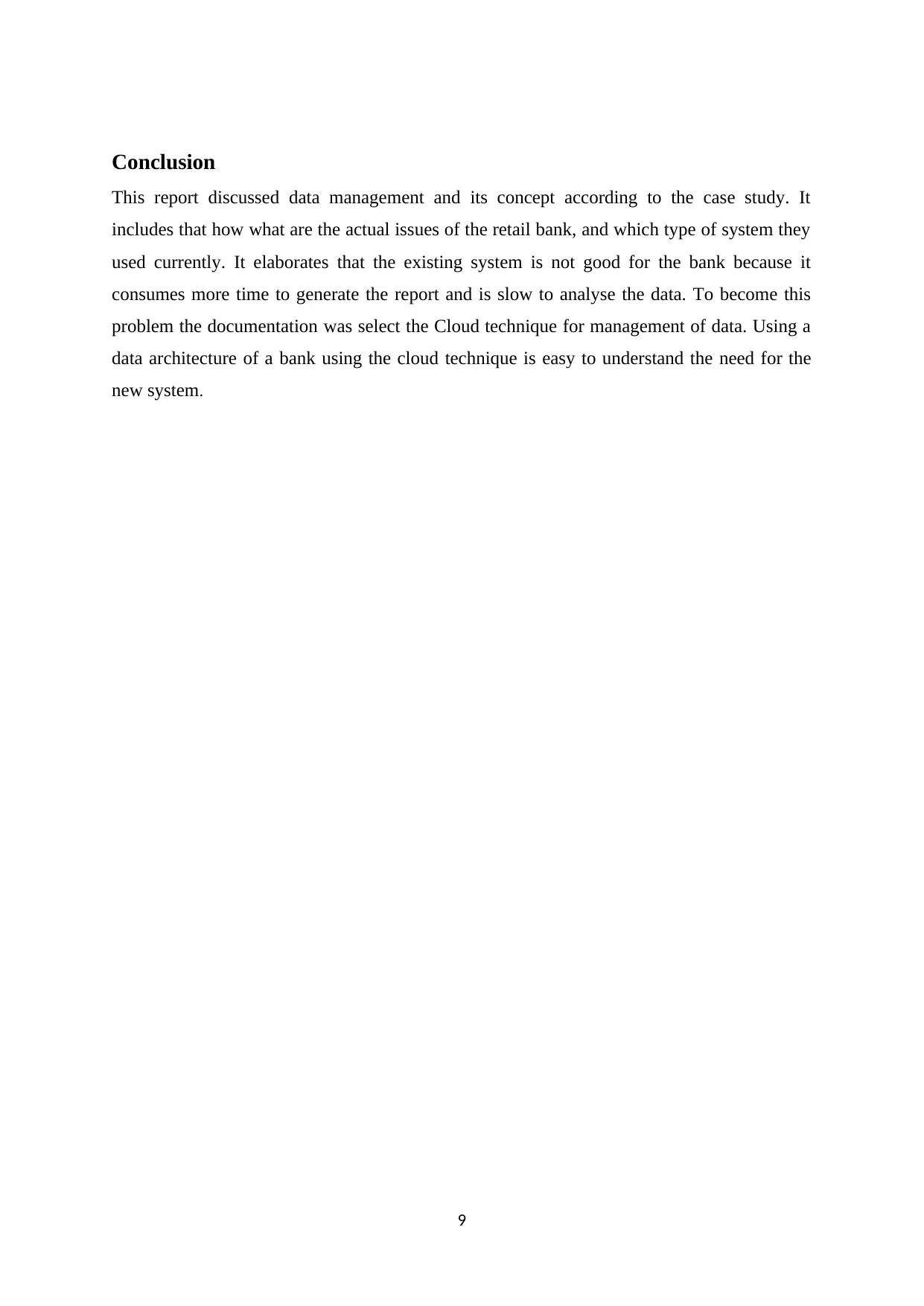
Conclusion
This report discussed data management and its concept according to the case study. It
includes that how what are the actual issues of the retail bank, and which type of system they
used currently. It elaborates that the existing system is not good for the bank because it
consumes more time to generate the report and is slow to analyse the data. To become this
problem the documentation was select the Cloud technique for management of data. Using a
data architecture of a bank using the cloud technique is easy to understand the need for the
new system.
9
This report discussed data management and its concept according to the case study. It
includes that how what are the actual issues of the retail bank, and which type of system they
used currently. It elaborates that the existing system is not good for the bank because it
consumes more time to generate the report and is slow to analyse the data. To become this
problem the documentation was select the Cloud technique for management of data. Using a
data architecture of a bank using the cloud technique is easy to understand the need for the
new system.
9
Paraphrase This Document
Need a fresh take? Get an instant paraphrase of this document with our AI Paraphraser
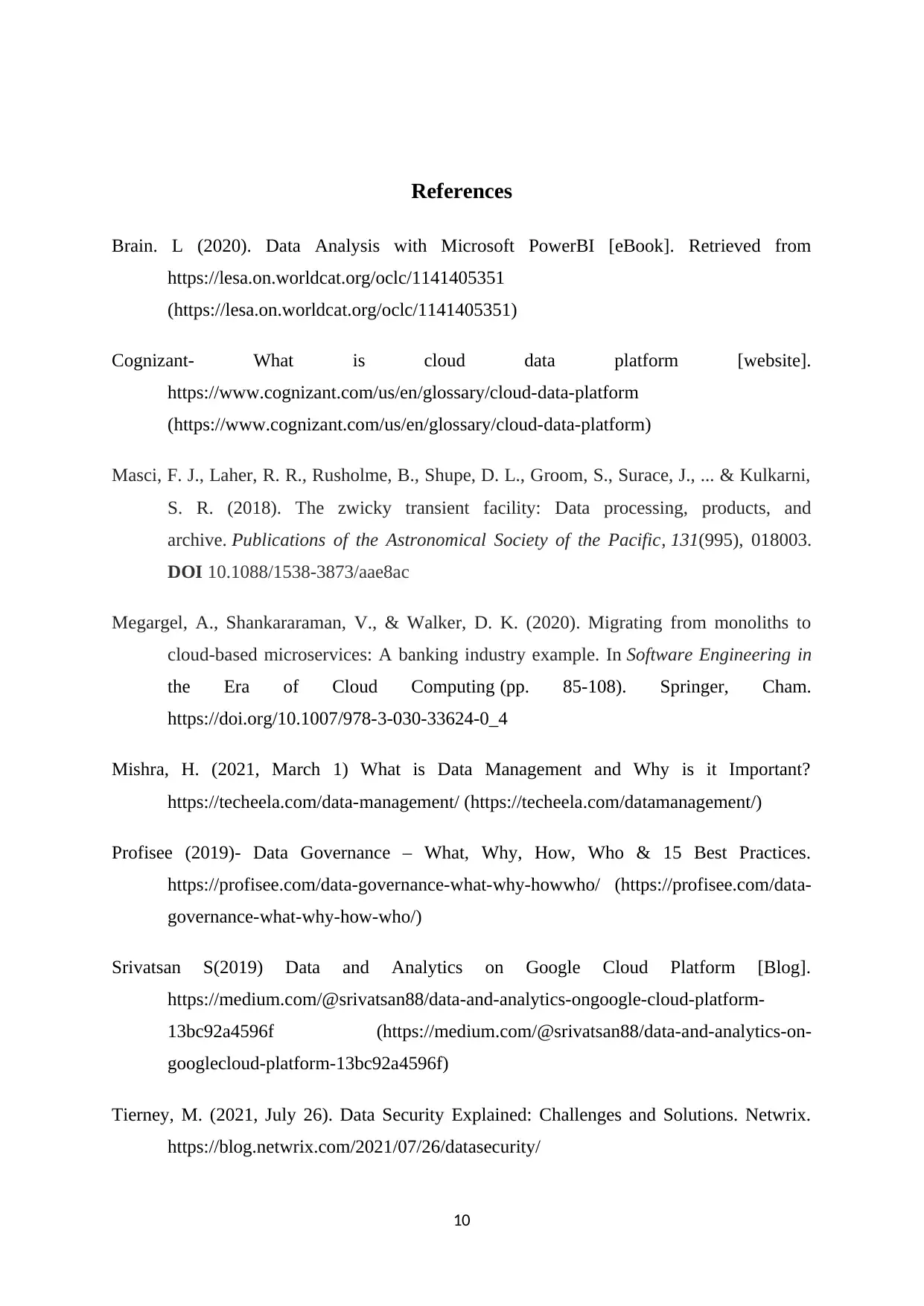
References
Brain. L (2020). Data Analysis with Microsoft PowerBI [eBook]. Retrieved from
https://lesa.on.worldcat.org/oclc/1141405351
(https://lesa.on.worldcat.org/oclc/1141405351)
Cognizant- What is cloud data platform [website].
https://www.cognizant.com/us/en/glossary/cloud-data-platform
(https://www.cognizant.com/us/en/glossary/cloud-data-platform)
Masci, F. J., Laher, R. R., Rusholme, B., Shupe, D. L., Groom, S., Surace, J., ... & Kulkarni,
S. R. (2018). The zwicky transient facility: Data processing, products, and
archive. Publications of the Astronomical Society of the Pacific, 131(995), 018003.
DOI 10.1088/1538-3873/aae8ac
Megargel, A., Shankararaman, V., & Walker, D. K. (2020). Migrating from monoliths to
cloud-based microservices: A banking industry example. In Software Engineering in
the Era of Cloud Computing (pp. 85-108). Springer, Cham.
https://doi.org/10.1007/978-3-030-33624-0_4
Mishra, H. (2021, March 1) What is Data Management and Why is it Important?
https://techeela.com/data-management/ (https://techeela.com/datamanagement/)
Profisee (2019)- Data Governance – What, Why, How, Who & 15 Best Practices.
https://profisee.com/data-governance-what-why-howwho/ (https://profisee.com/data-
governance-what-why-how-who/)
Srivatsan S(2019) Data and Analytics on Google Cloud Platform [Blog].
https://medium.com/@srivatsan88/data-and-analytics-ongoogle-cloud-platform-
13bc92a4596f (https://medium.com/@srivatsan88/data-and-analytics-on-
googlecloud-platform-13bc92a4596f)
Tierney, M. (2021, July 26). Data Security Explained: Challenges and Solutions. Netwrix.
https://blog.netwrix.com/2021/07/26/datasecurity/
10
Brain. L (2020). Data Analysis with Microsoft PowerBI [eBook]. Retrieved from
https://lesa.on.worldcat.org/oclc/1141405351
(https://lesa.on.worldcat.org/oclc/1141405351)
Cognizant- What is cloud data platform [website].
https://www.cognizant.com/us/en/glossary/cloud-data-platform
(https://www.cognizant.com/us/en/glossary/cloud-data-platform)
Masci, F. J., Laher, R. R., Rusholme, B., Shupe, D. L., Groom, S., Surace, J., ... & Kulkarni,
S. R. (2018). The zwicky transient facility: Data processing, products, and
archive. Publications of the Astronomical Society of the Pacific, 131(995), 018003.
DOI 10.1088/1538-3873/aae8ac
Megargel, A., Shankararaman, V., & Walker, D. K. (2020). Migrating from monoliths to
cloud-based microservices: A banking industry example. In Software Engineering in
the Era of Cloud Computing (pp. 85-108). Springer, Cham.
https://doi.org/10.1007/978-3-030-33624-0_4
Mishra, H. (2021, March 1) What is Data Management and Why is it Important?
https://techeela.com/data-management/ (https://techeela.com/datamanagement/)
Profisee (2019)- Data Governance – What, Why, How, Who & 15 Best Practices.
https://profisee.com/data-governance-what-why-howwho/ (https://profisee.com/data-
governance-what-why-how-who/)
Srivatsan S(2019) Data and Analytics on Google Cloud Platform [Blog].
https://medium.com/@srivatsan88/data-and-analytics-ongoogle-cloud-platform-
13bc92a4596f (https://medium.com/@srivatsan88/data-and-analytics-on-
googlecloud-platform-13bc92a4596f)
Tierney, M. (2021, July 26). Data Security Explained: Challenges and Solutions. Netwrix.
https://blog.netwrix.com/2021/07/26/datasecurity/
10

What is Data management? (n.d.) Oracle. Retrieved May 03, 2022, from
https://www.oracle.com/in/database/what-is-datamanagement/
11
https://www.oracle.com/in/database/what-is-datamanagement/
11
⊘ This is a preview!⊘
Do you want full access?
Subscribe today to unlock all pages.

Trusted by 1+ million students worldwide
1 out of 12
Related Documents
Your All-in-One AI-Powered Toolkit for Academic Success.
+13062052269
info@desklib.com
Available 24*7 on WhatsApp / Email
![[object Object]](/_next/static/media/star-bottom.7253800d.svg)
Unlock your academic potential
Copyright © 2020–2025 A2Z Services. All Rights Reserved. Developed and managed by ZUCOL.


